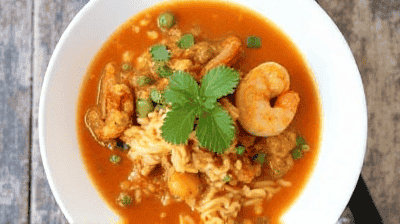

Are you ready to embark on a culinary journey that transports your taste buds to the vibrant streets of Thailand? Look no further than Spicy Thai Coconut Curry Soup with Shrimp and Rice Noodles – a dish that embodies the perfect balance of flavors, textures, and aromas. This creamy, spicy soup is not just a meal; it is a packet of warmth and comfort, perfect for any occasion.

Thai cuisine is renowned for its bold flavors and intricate balance of sweet, sour, salty, and spicy notes. Central to Thai cooking is the use of fresh herbs, spices, and ingredients that come together to create unforgettable dishes. Coconut milk, a staple in Thai cooking, lends a creamy richness to many soups and curries, providing a soothing contrast to spicy components.
When combined with shrimp and rice noodles, this soup transforms into a comforting bowl that is both satisfying and nourishing. Shrimp offers a delicate sweetness, while the rice noodles provide a hearty component that makes this dish perfect for any time of the year. Whether you are looking for a cozy meal on a chilly evening or a refreshing dish to enjoy on a warm day, this Spicy Thai Coconut Curry Soup ticks all the boxes.
The beauty of Thai coconut curry soup lies in its simplicity and the use of high-quality ingredients. To create a rich and flavorful bowl, you will need the following:
The star protein of the dish, shrimp, should be fresh or properly thawed if frozen. Large or jumbo shrimp work best, as they provide a satisfying bite and hold up well against the bold flavors of the soup.
Rice noodles, specifically rice vermicelli or flat rice noodles, are traditional in many Thai soups. They soak up the flavors of the broth and add a delightful texture.
Full-fat coconut milk is preferred for its rich flavor and creamy texture. It provides the base for the soup and balances the spices beautifully.
A good-quality Thai curry paste is essential for achieving the signature flavor of the soup. Red curry paste is common, but you can adjust based on your spice preference.
Fresh vegetables such as bell peppers, mushrooms, and bok choy contribute crunch and nutrition to the soup. You can customize the vegetable selection to include your favorites.
Chicken or vegetable broth serves as the foundation for the soup. It enhances the overall flavor and provides depth.
Fresh herbs, such as cilantro and basil, are crucial for garnishing and adding freshness. Additional spices, including ginger, garlic, and lime, enhance the aromatic profile of the dish.
Fresh lime juice is essential for adding brightness and balance to the soup. It cuts through the richness of the coconut milk and complements the flavors beautifully.
For those who enjoy heat, sliced Thai bird chilies or red pepper flakes can be added. For an extra layer of flavor, a splash of fish sauce or soy sauce lends a delicious umami element.

Now that we have a solid understanding of the key ingredients, let’s dive into the preparation of this flavorful soup. Follow these steps for a delightful culinary experience.
Shrimp: If using frozen shrimp, thaw them by placing them in the refrigerator for several hours or under cold running water for about 15 minutes. Peel and devein the shrimp if necessary and pat them dry with paper towels.
Noodles: Soak the rice noodles in hot water according to the package instructions. Typically, this takes about 10 to 15 minutes. Once cooked, drain and set aside.
Vegetables: Slice bell peppers, chop bok choy, and prepare any additional vegetables you wish to include.
Herbs: Rinse and roughly chop the cilantro and basil. Set aside for garnishing later.
Aromatics: Mince garlic and ginger, as they will be added at the beginning to build flavor.
Sauté Aromatics: In a large pot over medium heat, add a splash of vegetable oil. Once hot, add the minced garlic and ginger. Sauté for about 1 to 2 minutes until fragrant, being careful not to burn them.
Add Curry Paste: Stir in the Thai red curry paste, allowing it to toast slightly in the oil for about another minute. This step intensifies the flavors and releases the aromatic oils in the curry paste.
Add Broth and Coconut Milk: Pour in the chicken or vegetable broth and the full-fat coconut milk. Stir well to combine. Increase the heat to bring the mixture to a simmer.
Season the Soup: Add lime juice and a splash of fish sauce if desired. Taste and adjust seasoning to your liking, keeping in mind that the spices will develop as the soup simmers.
Add Vegetables: Once the soup comes to a simmer, add the sliced bell peppers, mushrooms, and bok choy. Let them cook for about 3 to 5 minutes until they are tender yet crisp.
Add the Shrimp: Drop the shrimp into the pot and cook for an additional 3 to 4 minutes or until the shrimp are pink and opaque. Be careful not to overcook the shrimp, as they can become rubbery.
Add Noodles: Now that the shrimp and vegetables are cooked through, gently stir in the soaked rice noodles.
Final Adjustments: Taste the soup one last time and make any final adjustments of lime juice or seasoning according to your preference.
Serve: Ladle the soup into bowls, ensuring each bowl gets a generous portion of shrimp, vegetables, and noodles. Garnish with fresh cilantro and basil leaves.
While the recipe above provides a wonderful foundation, there are various ways to enhance the flavor profile of your Spicy Thai Coconut Curry Soup. Here are some tips:
If you prefer a different level of heat or flavor, try mixing different types of curry paste. For instance, combining red and green curry paste can offer a complex flavor profile.
Make the soup your own by incorporating seasonal vegetables like zucchini, snap peas, or carrots. This not only adds variety but also elevates the nutritional value of the dish.
In addition to cilantro and basil, you can add fresh mint or Thai basil for a unique twist. Fresh herbs not only enhance the presentation but also add freshness to each bite.
For those who love extra heat, consider adding sliced Thai bird chilies or chili paste to the pot. This will intensify the spicy component of the soup.
Presentation is key when serving soups. Consider adding sliced red chilies, lime wedges, or even a drizzle of chili oil as a garnish for an eye-catching finish.

Beyond its incredible taste, this soup also offers a range of nutritional benefits. Here are some reasons to indulge in this delicious bowl:
Shrimp is an excellent source of lean protein, which is essential for muscle repair and overall health. It’s also low in calories, making it a great option for those watching their intake.
The added vegetables contribute various vitamins and minerals, including vitamin A, vitamin C, potassium, and dietary fiber. These nutrients are important for overall health and digestion.
Coconut milk provides healthy fats, which can be beneficial for heart health and satiety. The fats in coconut milk also make the soup feel more luxurious while still being nutritious.
The spices in curry, including ginger and garlic, are known for their anti-inflammatory properties. Including these ingredients in your diet can help reduce inflammation in the body.
To elevate your dining experience, consider serving the soup alongside complementary dishes and drinks. Here are some ideas:
Fresh Thai spring rolls filled with crispy vegetables and herbs are a perfect appetizer. Pair them with a sweet chili dipping sauce for contrast.
For a vegetarian option, serve crispy fried tofu on the side. It complements the soup well and adds a delightful crunch.
While the soup includes rice noodles, serving it with jasmine rice or coconut rice can enhance the meal, providing a hearty base for sopping up the delicious broth.
Coconut water is a refreshing beverage that pairs well with the rich flavors of the soup. It’s hydrating and complements the tropical theme of the meal.
A sweet and creamy Thai iced tea can balance the spiciness of the soup. The sweetened tea provides a delightful contrast, enhancing the overall dining experience.
If you are lucky enough to have leftovers, storing and reheating them properly is essential to maintaining the integrity of the dish. Here’s how:
Stovetop Method: Reheat the soup on the stovetop over low to medium heat. Stir occasionally until it is heated through. Add a splash of broth or coconut milk to maintain its creamy consistency.
Microwave Method: Alternatively, you can reheat the soup in a microwave-safe bowl. Heat in 30-second intervals, stirring in between until warmed.
While the shrimp and rice noodles can be reheated, they may lose some texture. For best results, consider cooking fresh noodles when reheating if possible.
If you want to change things up or cater to different dietary preferences, here are some variations of the Spicy Thai Coconut Curry Soup to consider:
Replace shrimp with tofu or chickpeas for a vegan take on the dish. Use vegetable broth and ensure that your curry paste does not contain any fish sauce or shrimp paste.
You can also experiment with other proteins such as chicken, fish, or scallops. Adjust the cooking time accordingly to ensure that the proteins are cooked thoroughly.
For those who enjoy extreme spiciness, incorporate additional chili flakes or hotter varieties of curry paste.
For an ultra-creamy soup, add an extra can of coconut milk or a splash of heavy cream for a richer texture.
Ensure that your rice noodles are labeled gluten-free, as some brands may contain gluten. All other ingredients should naturally fit within a gluten-free diet.
Spicy Thai Coconut Curry Soup with Shrimp and Rice Noodles is truly a flavor-packed bowl that brings the best of Thai cuisine to your kitchen. This dish is not only a feast for the taste buds but also a beautiful representation of the balance of flavors and textures found in Thai food. Whether you are enjoying it alone or sharing with friends and family, this soup is guaranteed to warm your heart and satisfy your cravings.
By following the steps outlined in this post, you can create a delightful and comforting meal that will impress even the most discerning palates. So gather your ingredients, embrace the spirit of Thai cooking, and get ready to enjoy a bowl of spicy goodness that will leave you wanting more.
Copyright © 2024 Taste Recipe. All rights by Taste Recipe.